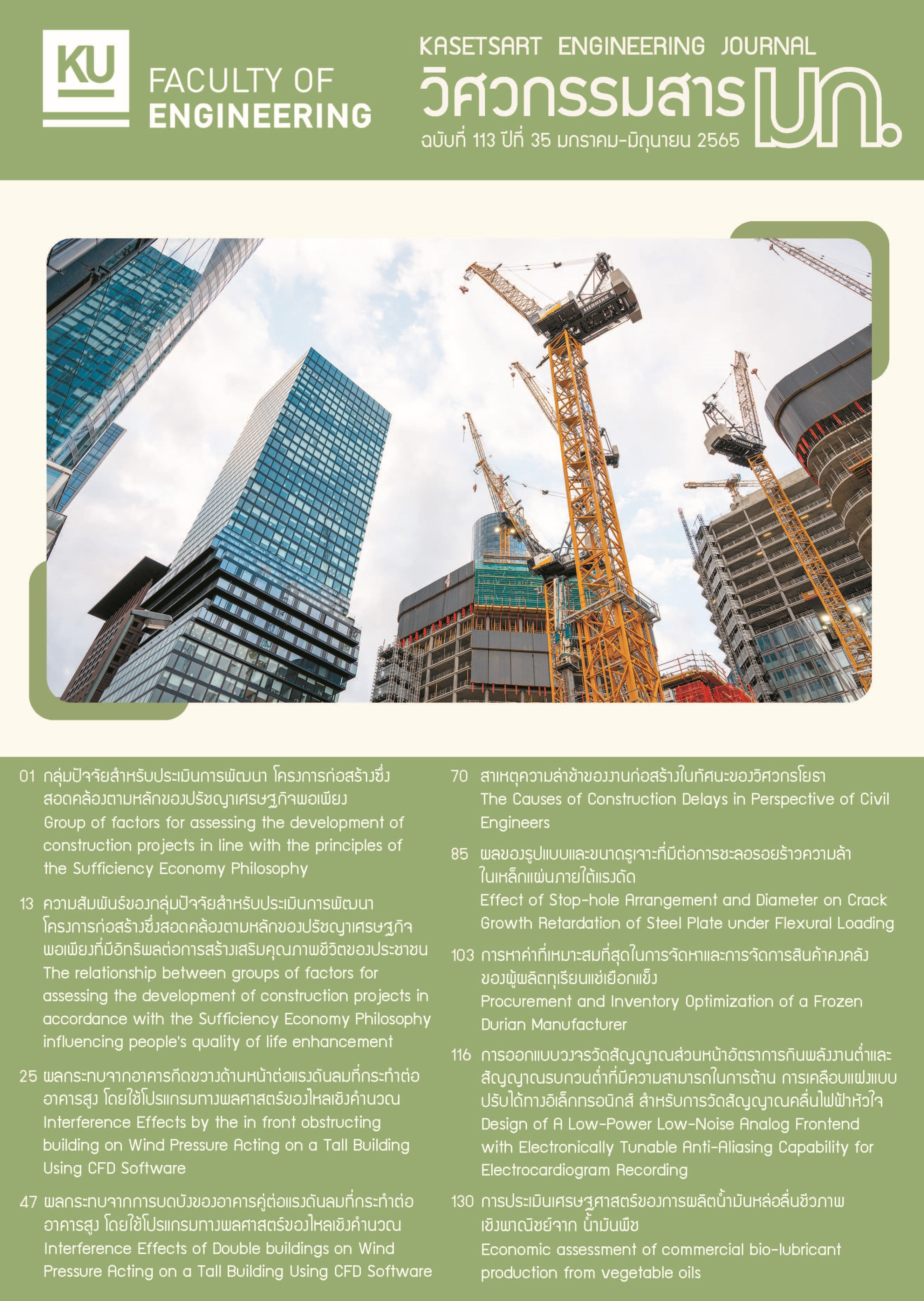The relationship between groups of factors for assessing the development of construction projects in accordance with the Sufficiency Economy Philosophy influencing people's quality of life enhancement
Keywords:
Construction project development, Sufficiency Economy Philosophy, Multiple regression methodAbstract
The purpose of this article is to study the relationship of a group of factors in the development of a construction project in accordance with the philosophy of sufficiency economy influencing on enhancing people's quality of life in accordance with the Sustainable Development Goal 17 (SDG17). The quantitative research was conducted by collecting data with a Likert scale at 5 levels from 138 engineers working on construction projects with over 5 years of work experience in public sectors, private sectors, and state enterprises. Then statistical data were analyzed by multiple regression analysis using a group of factors consisting of 7 independent variables and 4 dependent variables. The result found that there were only 5 groups of factors directly related to enhancing people's quality of life and the remaining two groups of factors were not directly related to enhancing people's quality of life. These two groups of factors will lead to a relationship that relies on the mediator variable, which is in accordance with the theory of the relationship of the sufficiency economy philosophy. The relationship concluded from this study can be analyzed in further research. This will enable the development of construction projects to proceed efficiently and in accordance with the sufficiency economy philosophy which will lead to long-term sustainability. As a result, the people in the country will be able to take full advantage of the developed projects and get the most benefit from the development of construction projects according to future urban expansion.
References
Asif M, Muneer T, and Kelly R (2007). Life cycle assessment: A case study of a dwelling home in Scotland. Journal of Building and Environment,42(2007), 1391-1394
Avery, G C & Bergsteiner, H (2016). Practices for Enhancing Resilience and Performance, in Sufficiency Thinking: Thailand’s Gift to an Unsustainable World, Avery & Bergsteiner (eds.) (pp. 235-247). Sydney: Allen & Unwin.
Charoenngam C, Posayanant S, Srivanich S, Orapan Khongmalai O, and Leungbootnak N (2003). KPIs for Infrastructure Development in Tambol Administration Organization. Damrong Rajanubhab; Office of the Permanent Secretary for Interior Ministry of Interior and Asian Institute of Technology. 1st edition printed at Asian Institute of Technology Klongluang PathumThani.
Fei W, Opoku A, Agyekum K, Oppon J, Ahmed V, Chen C and Lok K (2021). The Critical Role of the Construction Industry in Achieving the Sustainable Development Goals (SDGs): Delivering Projects for the Common Good by Sustainability 2021, 13(16), 9112; https://doi.o g/10.3390/su13169112r
Goubran S (2019). On the Role of Construction in Achieving the SDGs. Journal of Sustainability Research. J Sustain Res.2019;1: e190020; https://doi.org/10.20900/jsr20190020
Harvey P (2012). AN INTRODUCTION TO BUDDHIST ETHICS. Publish by Cambridge University Press June 2012; (pp 8-59), (pp187-238); DOI: https://doi.org/10.1017/CBO9780511800801
Harvey P (ed.) (2017). Common Buddhist text: guidance and insight from the Buddha. Mahachulalongkornrajavidyalaya University Press, Bangkok, Thailand.
Horayangkura V, Pimonsathean Y, Weesakul U, Lertpocasombut K, Romratanapun W, Wongsawatgul E, and Klinmalai, S (2007). “In Search of His Majesty the King’s Underlying Concepts in Royally-Initiated Urban, Community and Architecture Development.” Journal of Architectural/Planning Research and Studies, 5(3), 3-27. https://doi.org/10.56261/jars.v5i3.169038
Jibladze G, Romelashvili E, Chkheidze A, Modebadze E, Mukeria M (2021). Assessing Public Participation in Policymaking Process; WeResearch: Tbilisi, Georgia, 2021; (pp. 1–52).
Khaemmani T. (2015). Deciphering the philosophy of sufficiency economy to teach thinking processes: Chulalongkorn University Press.
Marome W (2017). A KNOWLEDGE ASSESSMENT ON SUSTAINABLE CITIES IN THAILAND; Sustainable City. Nakhon Pathom: Industrial Ecology Research and Training Center Faculty of Environment and Mahidol University Resource Center. P 144. ISBN 978-616-443-033-4.
NESDB (2019). NESDB ECONOMIC REPORT(pp. 1-32). https://www.nesdc.go.th/ewt_dl_link.php?nid=8429
Office of the Civil Service Commission (2009). Civil Service Code of Ethics, Royal Gazette, Vol. 126, Special Section 162-4, 73-86.
ORDPB. (2011). Sufficiency Economy Contests 2nd round. Bangkok: Office of the Royal Development Projects Board.
Pongvichai S. (2008). Computer analysis of statistical data. 19th edition Chulalongkorn University Press.
Queensland Government (1994). Public Sector Ethic Act 1994, Division 2 – The ethics values, Queensland Legislation.
Sonet U, Klufallah M, Peters M, and Dixon T (2021). Indicators of the Public Participation Exercise for Designing Public Parks in Malaysia: A Systematic Review. Sustainability 2021, 13(21), 12119; DOI: https://doi.org/10.3390/su132112119
State Services Commission (2005). New Zealand Public service code of conduct, published in pursuant to section 57 of the State Sector Act 1988, Reprint 2005, Crown Copyright, 32.
Terry L, Thomas N, and Skitmore M (2012). Public participation in infrastructure and
construction projects in China: From an EIA-based to a whole-cycle process. Journal of Habitat International 36, 47-56.
Thailand U. N. (2558). Sustainable Development Goals (SDGs). https://www.un.or.th/globalgoals/th/the-goals/.
The World Bank (1994). World Development Report 1994 Infrastructure for Development, Published by Oxford University Press, Inc.
United Nations Office for Project Services, (2014). THE SUSTAINABILITY MARKER TO SUPPORT THE PROJECT SELECTION PROCESS: THE UNOPS CASE. Accepted for publication at PMI Global Congress 2014 – North America Phoenix – Arizona – USA – 2014
Yudelson J (2010). Sustainable Retail Development: New Success Strategies.
Downloads
Published
Issue
Section
License

This work is licensed under a Creative Commons Attribution-NonCommercial-NoDerivatives 4.0 International License.


